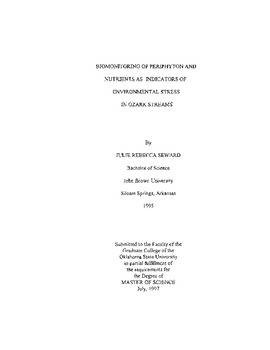| dc.description.abstract | Lakes and streams are vital sources of drinking water. The need to preserve these resources led to the Clean Water Act of 1972. One goal of this Act was to maintain the "physical, chemical, and biological integrity of the waters of the United States." As a result, the nation's water quality has improved (USEPA 1987). However, pollution still is occurring twenty years after this law was enacted. According to the United States Environmental Protection Agency's (EPA) ] 986 National Water Quality Inventory Report to Congress, nonpoint source (NPS) pollution is the leading cause of pollution of freshwater. Nonpoint sources, such as agricultural runoff, are responsible for 75% of polluted lakes and 65% of polluted streams in the United States (USEPA 1987). Nonpoint source loading of nitrogen and phosphorus in watersheds accelerates eutrophication of lakes, reservoirs, streams and rivers. Wetzel (1983) defines eutrophication as nutrient enrichment. Effects of this enrichment include increased primary productivity and hypolimnetic anoxia during summer stratification of lakes. Cultural eutrophication of streams has been linked to increased nutrients from NPS pollution originating in the watershed and can lead to excess algal growth and water quality degradation. Limnologists generally agree that the primary causal agents of eutrophication are increased loads of phosphorus and nitrogen (Vallentyne 1970~ Schindler 1974). Phosphorus has been shown to be the main agent of eutrophication; the greatest potential for increased biomass exists as a result of P loading (Vollenweider 1968; Vallentyne 1970; Hutchinson 1973). Controlling concentrations of nitrogen or carbon in a lake or reservoir are not feasible because of their atmospheric "sinks" (Schindler 1977). By controlling phosphorus loads that reach lakes, phytoplankton could be forced into phosphorus limitation and their productivity limited. Attenuation of NPS pollution to lotic systems would provide managers with a method to control phosphorus loading of lentic ecosystems. Such attenuation requires knowledge of ephemeral and spatial attributes of NPS pollution and the effects on the biota. Knowledge of possible sources of the NPS pollution also is necessary in development of a pollution management plan. Development of a biomonitoring approach to assess the rate at which nutrients are being loaded into a particular water body is also necessary if effective management of such loadings is to be achieved. Biomonitoring of nutrient concentrations is the topic of this proposal. | |
